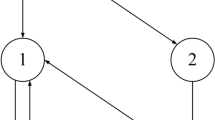Abstract
This paper addresses attitude synchronization problems for systems of multiple rigid-body agents with directed interconnection topologies. Two scenarios which differ in available information are considered. In the first scenario the agents can obtain their rotations and angular velocities relative to an inertial reference frame and transmit these information to their neighbors, while in the second scenario the agents can only obtain their own angular velocities and measure the relative rotations and relative angular velocities of their neighbors. By using rotation vectors and the high gain control, the authors provide torque control laws asymptotically synchronizing the rotations of the system almost globally for the first scenario and with initial rotations of the agents contained in a convex ball of SO(3) for the second scenario. An illustrative example is provided to show the synchronization results for both scenarios.
Similar content being viewed by others
References
Dimarogonas D, Tsiotras P, and Kyriakopoulos K, Leader-follower cooperative attitude control of multiple rigid bodies, Syst. Control Lett., 2009, 58(6): 429–435.
VanDyke M C and Hall C D, Decentralized coordinated attitude control within a formation of spacecraft, J. Guid. Control Dyn., 2006, 29(5): 1101–1109.
Ren W, Distributed cooperative attitude synchronization and tracking for multiple rigid bodies, IEEE Trans. Control Syst. Technol., 2010, 18(2): 383–392.
Wu B, Wang D, and Poh E, Decentralized sliding-mode control for attitude synchronization in spacecraft formation, Int. J. Robust Nonlinear Control, 2013, 23(11): 1183–1197.
Jin E, Jiang X, and Sun Z, Robust decentralized attitude coordination control of spacecraft formation, Syst. Control Lett., 2008, 57(7): 567–577.
Chaturvedi N A, Sanyal A K, and McClamroch N H, Rigid-body attitude control, IEEE Control Syst. Mag., 2011, 31(3): 30–51.
Sarlette A, Sepulchre R, and Leonard N E, Autonomous rigid body attitude synchronization, Automatica, 2009, 45(2): 572–577.
Tron R, Afsari B, and Vidal R, Riemannian consensus for manifolds with bounded curvature, IEEE Trans. Autom. Control, 2013, 58(4): 921–934.
Thunberg J, Song W, and Hu X, Distributed attitude synchronization control of multi-agent systems with directed topologies, Proceedings of the 10th World Congress on Intelligent Control and Automation, Beijing, 2012.
Thunberg J, Song W, Hong Y, and Hu X, Distributed attitude synchronization using backstepping and sliding mode control, Control Theory and Technol, 2014, 12(1): 48–55.
Moakher M, Means and averaging in the group of rotations, SIAM J. Matrix Anal. Appl., 2002, 24(1): 1–16.
Shuster M, A survey of attitude representations, J. Astronaut. Sci., 1993, 41(4): 439–517.
Godsil C and Royle G, Algebraic Graph Theory, Springer-Verlag, New York, 2001.
Berman A, Varga R S, and Wardd R C, ALPS: Matrices with nonpositive off-diagonal entries, Linear Algebra and Appl., 1978, 21: 233–244.
Song W, Thunberg J, Hong Y, and Hu X, Distributed attitude synchronization control of multiagent systems with time-varying topologies, Proceedings of the 10th World Congress on Intelligent Control and Automation, Beijing, 2012.
Ma Y, Soatto S, Košecká J, and Sastry S, An Inviatation to 3-D Vision: From Images to Geometric Models, Springer-Verlag, New Yourk, 2003.
Khalil H, Nonlinear Systems, Prentice Hall, New Jersey, 2002.
Giorgi G and Komlósi S, Dini derivatives in optimization — Part I, Decisions Econ. Finan., 1992, 15(1): 3–30.
Rouche N, Habets P, and Laloy M, Stability Theory by Liapunov’s Direct Method, Springer-Verlag, New York, 1977.
Szarski J, Differential Inequalities, PWN, Warszawa, 1965.
Carmo M, Riemannian Geometry, Birkhäuser, Boston, 1992.
Afsari B, Riemannian L p center of mass: Existence, uniqueness, and convexity, Proc. Amer. Math. Soc., 2011, 139(2): 655–655.
Author information
Authors and Affiliations
Corresponding author
Additional information
This work was supported by Beijing Natural Science Foundation under Grant No. 4152057 and 973 program (2014CB845301/2/3).
This paper was recommended for publication by Editor LÜ Jinhu.
Rights and permissions
About this article
Cite this article
Song, W., Thunberg, J., Hu, X. et al. Distributed high-gain attitude synchronization using rotation vectors. J Syst Sci Complex 28, 289–304 (2015). https://doi.org/10.1007/s11424-015-3107-3
Received:
Revised:
Published:
Issue Date:
DOI: https://doi.org/10.1007/s11424-015-3107-3



